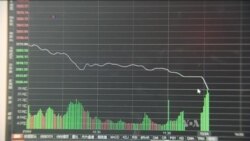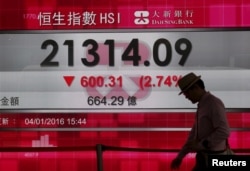It’s been a turbulent start to 2016 for global financial markets, with big drops in the value of shares Monday. The sell-off began in China – where concerns are growing over the quickening pace of the slowdown.
Stock markets in the cities of Shanghai and Shenzhen were suspended Monday after falling more than 7 percent on the opening day of 2016 trading.
The sell-off triggered the so-called circuit-breaker mechanism for the first time – a system designed byt the Chinese government to prevent volatility by halting trades.
A 64-year-old trader believes the government intervention was unnecessary. He says he is in favor of the 'circuit breaker' mechanism - but the government implementing it on the first day is like testing the market.
It’s the millions of individual Chinese investors – many of them pensioners – that drive volatility, says analyst John Driffill of Birkbeck College University of London.
“The Chinese stock market is populated by a large number of small investors who are very prone to panics and booms and crashes," he said. "They are exchanging information and rumors. These are stock market players with a very short-term perspective. They’re gambling with small amounts of life savings.”
The market drops were driven by a survey showing that activity in Chinese factories contracted for the 10th straight month in December, and at a sharper pace than in November.
"It's just renewed the same fears that dogged a lot of last year's trading, namely that the slowdown in China's economy could be set to speed up,” said Jasper Lawler, who is with the investment group CMC Capital Markets.
Those fears were echoed in European and U.S. markets – which also saw falls of several percent.
Figures due out later this year are expected to show that China posted its weakest economic growth for 25 years in 2015 - slipping to around 7 percent.
Analysts say concerns over worsening tensions between Saudi Arabia and Iran are also weighing on stock markets – and driving up the price of oil.









